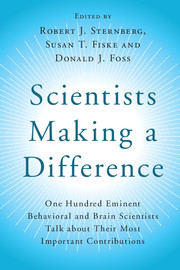 Scientists Making a Difference
Scientists Making a Difference from Section B - Emotion
Published online by Cambridge University Press: 05 August 2016
Even as a child I was interested in aggression. There likely are many reasons, including having an older brother who was much larger, stronger, and smarter; being the smallest boy in my grade level; and hating to lose. I was both frustrated and angry a lot. My favorite TV shows all involved violence, including classic Westerns (e.g., Maverick, Sugarfoot) and World War II shows (e.g., Combat, Rat Patrol). By the time I was fourteen, though, I knew that being angry and breaking things was neither enjoyable nor productive. In high school I paid close attention to the ongoing Vietnam war and the growing student protest movement. The killings at Kent State University had a major impact on my thinking and my bewilderment about violence. Army Basic Training yielded another major insight; it is trivially easy to learn how to kill another person with an M16 rifle.
At a theoretical level, my most important scientific contribution has been the development of a broad-based interdisciplinary model of human aggression: the General Aggression Model (GAM). Its roots lie in contributions by many scholars going back many years, from scholars whose primary work was in the aggression and violence domain, and from scholars whose primary work was in basic social, cognitive, developmental, personality, and biological psychology. Briefly, GAM illustrates how factors from the current situation (e.g., provocation) interact with personality factors (e.g., attitudes toward and expectations about aggression) and life history (e.g., growing up in a family that hunts animals for recreation) to increase or decrease one's likelihood of behaving aggressively when faced with potential conflict. It views the development of personality as a learning process that is rooted in biological processes but also is strongly influenced by events that a person experiences and observes.
My path from graduate student to aggression scholar was convoluted, and not at all “planful.” My early focus was on human inference and decision-making, a focus that required understanding how people think, what heuristics they use, and what kinds of situational variables influence the inference process. A parallel interest was in attribution processes – that is, how people come to explain events that they experience or observe.
To save this book to your Kindle, first ensure no-reply@cambridge.org is added to your Approved Personal Document E-mail List under your Personal Document Settings on the Manage Your Content and Devices page of your Amazon account. Then enter the ‘name’ part of your Kindle email address below. Find out more about saving to your Kindle.
Note you can select to save to either the @free.kindle.com or @kindle.com variations. ‘@free.kindle.com’ emails are free but can only be saved to your device when it is connected to wi-fi. ‘@kindle.com’ emails can be delivered even when you are not connected to wi-fi, but note that service fees apply.
Find out more about the Kindle Personal Document Service.
To save content items to your account, please confirm that you agree to abide by our usage policies. If this is the first time you use this feature, you will be asked to authorise Cambridge Core to connect with your account. Find out more about saving content to Dropbox.
To save content items to your account, please confirm that you agree to abide by our usage policies. If this is the first time you use this feature, you will be asked to authorise Cambridge Core to connect with your account. Find out more about saving content to Google Drive.